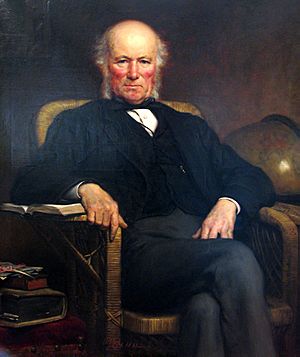William Pengelly facts for kids
William Pengelly (born January 12, 1812 – died March 16, 1894) was a British geologist and amateur archaeologist. He was one of the first scientists to find strong evidence that the Earth is much older than some people believed based on certain religious timelines. His discoveries helped change how people understood the history of our planet and early humans.
Who Was William Pengelly?
William Pengelly was born in a place called Looe in Cornwall, England. His father was a sea captain. William left school when he was only 12 years old to work with his dad on a ship.
When he was a teenager, he came back to Looe. He spent a lot of time reading books and learning about mathematics. Around 1836, he moved to Torquay and started his own school. He taught using a popular method called Pestalozzian, which focused on hands-on learning.
In 1846, Pengelly stopped running his school. He became a private teacher and began giving talks about science. He continued to lecture on scientific topics for the rest of his life.
Pengelly's Early Scientific Work
Pengelly published his first scientific paper in 1849. It was about fossil fish found in East Cornwall. This was just the beginning! He went on to publish about 120 papers. These papers covered topics like geology (the study of Earth's rocks and history), palaeontology (the study of fossils), and human prehistory (the time before written records).
In 1862, Pengelly wrote an important paper about the geology of lignite (a type of coal) found in Bovey Tracey. He presented this paper to the Royal Society, a very important group of scientists. The next year, he was chosen to be a member of the Royal Society.
Helping Others Learn About Science
William Pengelly really wanted to help people learn. He started several groups to encourage learning and science:
- The Torquay Young Men's Society (which later became the Torquay Mechanics' Institute).
- The Torquay Natural History Society.
- The Devonshire Association for the Advancement of Literature, Science, and Art (started in 1862).
He also wrote articles for the Transactions of the Royal Geological Society of Cornwall.
Pengelly's Family Life
In 1838, Pengelly married his cousin, Mary Ann Mudge. They had three children. Sadly, Mary Ann passed away in 1851. Two years later, he married Lydia Spriggs. Lydia was from a Quaker family. They had two daughters. His younger daughter, Hester, later wrote a book about her father's life.
What Were Pengelly's Biggest Discoveries?
Pengelly's most important work was exploring caves in Devon, England. He wanted to find out if early humans lived in these caves.
Exploring Kents Cavern
He excavated at Kents Cavern, a famous cave in Devon. Other scientists, like Father John MacEnery, had worked there before him. Pengelly found similar evidence: Palaeolithic (Stone Age) flint tools and bones of animals that are now extinct. These items were found together in the same layers of rock.
Pengelly was lucky because he worked at a time when people were more open to new ideas about geology and religion. This helped him get support and money to publish his and MacEnery's findings. However, some people still doubted his discoveries. They thought that maybe later items had somehow fallen into older layers of the cave, since it had been dug up many times.
The Breakthrough at Windmill Hill Cavern
In 1858, a new cave was found called Windmill Hill Cavern. This cave gave Pengelly a perfect chance to test his ideas. The Royal Society and the Geological Society of London oversaw his work. He worked with another archaeologist named John Evans.
They carefully dug in the cave. They found an unbroken sheet of stalagmite (a rock formation) covering the cave floor. Underneath this sheet, they found bones of animals like cave lions and woolly rhinoceroses. They also found human-made flint tools right next to them!
This discovery was very important. It proved that Stone Age humans lived at the same time as these extinct animals. This showed that humans had been around for a very long time, much longer than some people believed.
After this success, Pengelly went back to Kents Cavern in 1864. He spent another fifteen years carefully digging. His goal was to further prove that humans lived alongside animals that are now extinct. His work, along with others like Jacques Boucher de Crèvecœur de Perthes, provided strong arguments against the traditional timelines of Earth's history.
Pengelly and Charles Darwin
Pengelly also exchanged letters with famous scientists like Charles Darwin. In these letters, he shared the results of his discoveries. Pengelly's findings, along with those of John Evans, led them to conclude that the traditional Biblical timeline of Earth's history did not match what they found in their research. They made this case strongly in 1859.
Important Scientists Who Supported Pengelly
When William Pengelly was elected to the Royal Society in 1863, many important scientists signed his nomination. This shows how respected he was. Some of them included:
- Charles Babbage – Known as the "father of the computer."
- Sir Charles Lyell – Often called the "father of British Geology."
- Sir Roderick Murchison – A Scottish geologist who studied ancient rock systems.
- Sir Andrew Ramsay – A Scottish geologist who became Director-General of the Geological Survey.
These famous names show that Pengelly's work was highly valued by the leading scientific minds of his time.
See also
- Antiquity of man


